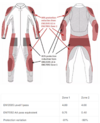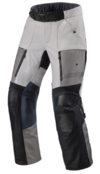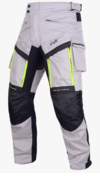This was an eye-opener for me. It started when the zipper broke on my go-to riding pants, some old Olympia Dakar pants. They were what I was wearing when I had the accident a year ago. So while I'm trying to get the zipper replaced, I started looking for what was available as a possible replacement. One of the possibilities was "riding jeans". An offshoot from that was learning about the EN17092 certification levels.
Over the last few years, I've noticed that riding gear material is thinner and more supple to the touch. It used to be that Cordura was the standard fabric that everyone used, but now they are using other trademarked names for polyester type materials. KARBONITE. ProTechWool. My Olympia Ranger jacket has 2000d Cordura in the impact areas. It's heavy to pick up. Not like the new stuff at all. Are those other materials as good? All we can do is to trust the manufacturers.
I got an email from Bob's BMW today announcing their latest sale, so I went window shopping to see what they had available. And what I saw in the descriptions surprised me. I thought riding pants were supposed to be superior for protection than riding jeans. My Revit! Lombard 3 pants that I just purchased (and haven't decided on keeping), have a EN17092 AA certification. And that is the same as the certification for some of the top level riding pants I looked at. I would've thought the pants would meet the AAA rating, but they don't.
Before you get to thinking a AA certification rating is great, this is all it means. Class AA garments must withstand abrasion for 5 seconds at a speed of 75 kilometers per hour, or 46 mph.
This is a well written article asking a good question. The new EN17092 standard is actually 90% less protection than the old standard EN13595. I didn't expect that.

There's a lot more to read in the article than this diagram. I hope you take the time to read the whole article.
So what is the difference between my HWK pants that sell for $59 and the KLIM, Revit! or Alpenstars pants that sell for 15 times more?
Chris
Over the last few years, I've noticed that riding gear material is thinner and more supple to the touch. It used to be that Cordura was the standard fabric that everyone used, but now they are using other trademarked names for polyester type materials. KARBONITE. ProTechWool. My Olympia Ranger jacket has 2000d Cordura in the impact areas. It's heavy to pick up. Not like the new stuff at all. Are those other materials as good? All we can do is to trust the manufacturers.
I got an email from Bob's BMW today announcing their latest sale, so I went window shopping to see what they had available. And what I saw in the descriptions surprised me. I thought riding pants were supposed to be superior for protection than riding jeans. My Revit! Lombard 3 pants that I just purchased (and haven't decided on keeping), have a EN17092 AA certification. And that is the same as the certification for some of the top level riding pants I looked at. I would've thought the pants would meet the AAA rating, but they don't.
Before you get to thinking a AA certification rating is great, this is all it means. Class AA garments must withstand abrasion for 5 seconds at a speed of 75 kilometers per hour, or 46 mph.
This is a well written article asking a good question. The new EN17092 standard is actually 90% less protection than the old standard EN13595. I didn't expect that.
https://www.bennetts.co.uk/bikesocial/news-and-views/features/product/motorcycle-ce-safety-standards

There's a lot more to read in the article than this diagram. I hope you take the time to read the whole article.
So what is the difference between my HWK pants that sell for $59 and the KLIM, Revit! or Alpenstars pants that sell for 15 times more?
Chris





